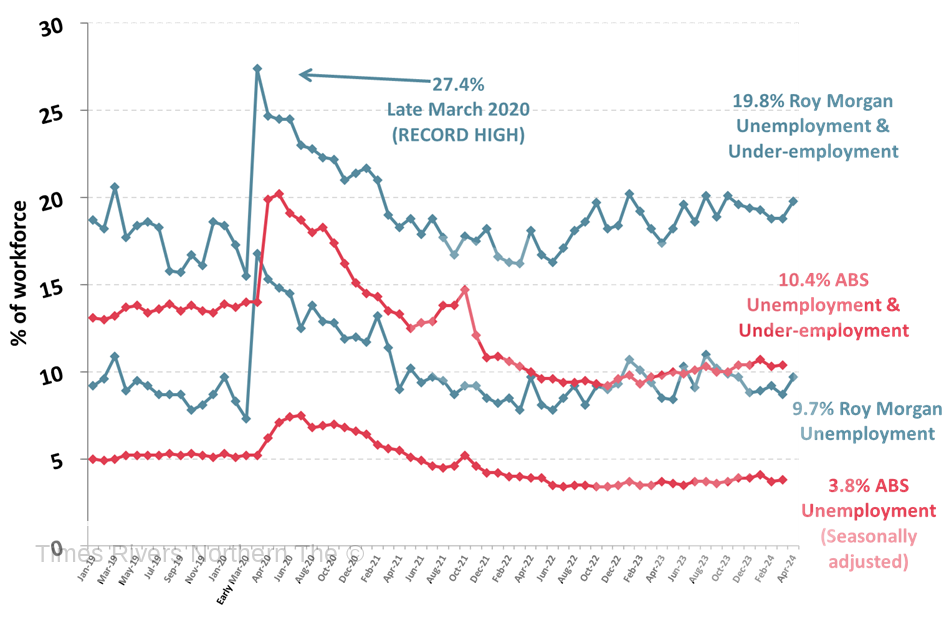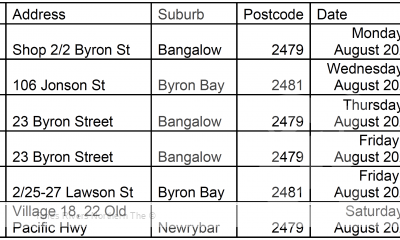Australian unemployment increases in April to 9.7% – overall labour under-utilisation at highest since October 2020
In April 2024, Australian ‘real’ unemployment increased 177,000 to 1,535,000 (up 1% to 9.7% of the workforce) despite overall employment remaining near its all-time high at over 14.2 million.
In addition to the increase in unemployment, there was also a slight increase in under-employment, up 18,000 to 1,594,000. These combined increases mean a massive 3.13 million Australians (19.8% of the workforce, up 1%) were unemployed or under-employed in April – the highest level of total labour under-utilisation for over three years since October 2020 (3.15 million) during the early months of the pandemic.
The April Roy Morgan Unemployment estimates were obtained by surveying an Australia-wide cross section of people aged 14+. A person is classified as unemployed if they are looking for work, no matter when. The ‘real’ unemployment rate is presented as a percentage of the workforce (employed & unemployed).
- Overall employment remains near all-time record high at over 14.2 million in April:
Australian employment was down slightly by 35,000 to 14,232,000 in April. A significant fall in part-time employment drove the decrease, down 261,000 to 4,903,000 while full-time employment increased by 226,000 to 9,329,000.
- Unemployment increased in April with 177,000 more Australians looking for work:
In April 1,535,000 Australians were unemployed (9.7% of the workforce, up 1%), an increase of 177,000 from March driven by more people looking for both full-time and part-time work. There were 669,000 (up 74,000) looking for full-time work and 866,000 (up 103,000) looking for part-time work.
- Overall unemployment and under-employment increased by 1% to 19.8% in April:
In addition to the unemployed, a further 1.59 million Australians (10.1% of the workforce) were under-employed, i.e. working part-time but looking for more work, up 18,000 from March. In total 3.13 million Australians (19.8% of the workforce) were either unemployed or under-employed in April.
- Comparisons with a year ago show rapidly increasing workforce driving employment growth:
The workforce in April was 15,767,000 (up 142,000 from March and up a massive 717,000 from a year ago) – comprised of 14,232,000 employed Australians (down 35,000 from a month ago) and 1,535,000 unemployed Australians looking for work (up 177,000 from a month ago).
Although unemployment and under-employment remain high at 3.13 million – the highest combined figure since October 2020 during the early months of the pandemic, there has been a surge in employment over the last year – up by a large 418,000 to a near record high of 14,232,000.
ABS Comparison
Roy Morgan’s unemployment figure of 9.7% is more than double the ABS estimate of 3.8% for March but is approaching the combined ABS unemployment and under-employment figure of 10.3%.
The latest monthly figures from the ABS indicate that the people working fewer hours in March 2024 due to illness, injury or sick leave was 537,100. This is around 146,000 higher than the pre-pandemic average of the five years to March 2019 (391,300) – a difference of 145,800.
If this higher than pre-pandemic average of workers (145,800) is added to the combined ABS unemployment and under-employment figure of 1,541,200 we find a total of 1,687,000 people could be considered unemployed or under-employed, equivalent to 11.4% of the workforce.

Source: Roy Morgan Single Source January 2019 – April 2024. Average monthly interviews 5,000.
Note: Roy Morgan unemployment estimates are actual data while the ABS estimates are seasonally adjusted.
Michele Levine, CEO Roy Morgan, says total Australian unemployment or under-employment has increased to its highest in over three years at 3.13 million in April – 19.8% of the workforce – with over 1.5 million people either unemployed or under-employed:
“The latest Roy Morgan employment estimates for April show total Australian unemployment or under-employment (also known as labour underutilisation) has increased 195,000 to 3,129,000 (19.8% of the workforce, up 1%). ’Real’ unemployment increased 177,000 to 1,535,000 (9.7% of the workforce) and under-employment increased by 18,000 to 1,594,000 (10.1%).
“This is the first time in over a year that both unemployment and under-employment have increased in the same month with the two usually moving in opposite directions. The increase means overall labour under-utilisation is now at its highest for over three years since October 2020 (3.15 million) during the early days of the pandemic.
“The labour force has experienced rapid change over the last year with a large increase in population (+717,000) – a rate almost three times higher than the average annual population growth over the last 25 years of 287,000. This population increase has been the driver of a growing workforce, up by 667,000 to a record high of over 15.7 million in April 2024.
“In turn, the increasing workforce has led to large rises in both employment, up 418,000 to over 14.2 million, and unemployment, up 249,000 to 1,535,000. As well as unemployment increasing 249,000, under-employment is up by 254,000 – a combined figure of 503,000 more Australians either unemployed or under-employed than a year ago in April 2023.
“The figures show that although new jobs are being created, there are not enough jobs being created to soak up the nearly 700,000 people who joined the workforce over the last year and increasing numbers of Australians are becoming unemployed or under-employed.”
“The sustained increase in unemployment and under-employment over the last year shows the labour market is struggling to provide the right jobs for all those joining the workforce. Tackling this continuing high level of unemployment and under-employment must be the number one priority for the Federal Government which is due to hand down a pre-election Federal Budget this week.”
This Roy Morgan survey on Australia’s unemployment and ‘under-employed’* is based on weekly interviews of 974,626 Australians aged 14 and over between January 2007 and April 2024 and includes 6,020 telephone and online interviews in April 2024. *The ‘under-employed’ are those people who are in part-time work or freelancers who are looking for more work.
For more business news, click here.





 Tweed Shire News2 years ago
Tweed Shire News2 years ago
 Motoring News1 year ago
Motoring News1 year ago
 COVID-19 Northern Rivers News3 years ago
COVID-19 Northern Rivers News3 years ago
 COVID-19 Northern Rivers News3 years ago
COVID-19 Northern Rivers News3 years ago
 Northern Rivers Local News3 years ago
Northern Rivers Local News3 years ago
 Health News3 years ago
Health News3 years ago
 COVID-19 Northern Rivers News3 years ago
COVID-19 Northern Rivers News3 years ago
 NSW Breaking News3 years ago
NSW Breaking News3 years ago























